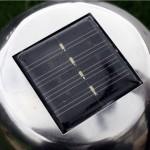Latest developments in solar photovoltaics
Recent developments in solar electricity generation include spray on photovoltaic cells and a new generation of hybrid silicon/carbon solar cells.
 As scientists continue to look at ways of bringing the costs of solar photovoltaic panels down further, some of the best experts in the UK have got together to develop a spray coating technique. Scientists from the University of Cambridge and the University of Sheffield have been able to replicate the method used to spray paint motor vehicles, which they are claiming can also be used in the manufacture of solar cells.
As scientists continue to look at ways of bringing the costs of solar photovoltaic panels down further, some of the best experts in the UK have got together to develop a spray coating technique. Scientists from the University of Cambridge and the University of Sheffield have been able to replicate the method used to spray paint motor vehicles, which they are claiming can also be used in the manufacture of solar cells.
According to Sheffield University’s Professor David Lidzey research carried out by his team has revealed that the way spray coated solar cells perform is the same as cells manufactured in more traditional methods: “We found that the performance of our spray coated solar cells is the same as cells made with more traditional research methods, but which are impossible to scale in manufacturing,” he explained.
Unlike silicon solar cells, cells made from plastic require far less energy. However as a material plastic cannot generate electricity as efficiently as silicon. Not only that, solar panels made from silicon have a life expectancy of 25 years. While it’s doubtful that plastic solar cells would ever be able to compete, scientists are claiming that if energy costs can be lowered sufficiently plastic solar cells could potentially become more effective over their life cycle, compared to silicon cells. Scientists are currently working on increasing the energy conversion efficiency and the life cycle of plastic solar cells.
Given that the cost of solar panels made from silicon have dropped significantly plastic solar cells will have their work cut out if they are to rival silicon solar panel technology.
In other news across the pond, engineers from Yale University have discovered that a higher energy conversion efficiency can be achieve by combining carbon nanotube technology with traditional crystalline silicon materials. Thin films made from carbon nanotubes were layered onto a single-crystalline silicon base to create a new generation of efficient hybrid carbon/silicon solar cells.
Carbon nanotubes are increasingly being used in energy storage systems including lithium ion batteries as well as in organic solar cell technology. Although cheap to make, the efficiency of solar cells manufactured from organic material has never been able to match that of silicon cells.
As the key component of monocrystalline solar panels single-crystalline silicon is traditionally favoured because of its excellent energy conversion characteristics.
Xiaokai Li, a doctoral student and a lead author said the secret lies in the arrangement and assembly of the carbon nanotube thin films: “This is striking, as it suggests that the superior photovoltaic properties of single-crystalline silicon can be realized by a simple, low-temperature process.”
The findings have been published in the scientific journals Energy and Environmental Science and Nano Letters.
Find local, MSC certified Solar Installers
Start your quote
Find local, MSC certified Solar Installers















